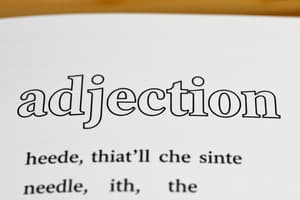Podcast
Questions and Answers
In English grammar, what kind of adjective usually comes first in a list of multiple adjectives that modify a noun?
In English grammar, what kind of adjective usually comes first in a list of multiple adjectives that modify a noun?
- Evaluative adjectives
- Descriptive adjectives (correct)
- Temporary states or conditions
- Permanent descriptors
Which type of adjective refers to inherent traits and precedes other adjectives in English grammar?
Which type of adjective refers to inherent traits and precedes other adjectives in English grammar?
- Temporary states or conditions
- Evaluative adjectives
- Permanent descriptors (correct)
- Descriptive adjectives
Where do temporary states or conditions typically appear in the order of multiple adjectives?
Where do temporary states or conditions typically appear in the order of multiple adjectives?
- First
- Third (correct)
- Last
- Second
Which type of adjective usually conveys opinions, likes, dislikes, emotions, attitudes, etc., and is placed last in the order of multiple adjectives?
Which type of adjective usually conveys opinions, likes, dislikes, emotions, attitudes, etc., and is placed last in the order of multiple adjectives?
If you were describing a car as 'shiny, luxurious vehicle,' which type of adjective is 'shiny' considered in this context?
If you were describing a car as 'shiny, luxurious vehicle,' which type of adjective is 'shiny' considered in this context?
In the phrase 'beautiful white dress,' what type of adjective is 'beautiful' based on the information provided?
In the phrase 'beautiful white dress,' what type of adjective is 'beautiful' based on the information provided?
Study Notes
Opinion Adjective Placement
In English grammar, when multiple adjectives modify a noun, they often follow a specific order based on their meaning. One of these orders is according to their level of subjectivity:
- Descriptive adjectives - These describe physical qualities such as color, texture, weight, etc., and typically come first in the list. For example, "The red, sparkling diamond."
- Permanent descriptors – These refer to inherent traits like species, material, substance, etc., and also precede other adjectives. "Grey kitten with yellow eyes."
- Temporary states or conditions can appear next, describing the state of something at a particular moment. "A warm coat kept her comfortable."
- Evaluative adjectives are last because they convey opinions, likes, dislikes, emotions, attitudes, etc..
For instance, if you were to describe your favorite coffee cup, it could go like this: "My ceramic mug, large enough for comfortably sipping my aromatic espresso, has a soft grip that pleases me tremendously." In this case, the relative importance of each characteristic would guide ordering; thus, the most important attribute (evaluative) comes last.
However, there's another factor to consider—the nature of adjectives themselves! If we have two evaluative adjectives ("tremendously nice," "extremely useful"), they may switch places based on how they compare against one another within that context. So while evaluative adjectives generally follow other modifiers, exceptions exist due to their semantic relationships within sentences.
Studying That Suits You
Use AI to generate personalized quizzes and flashcards to suit your learning preferences.
Description
Understand the correct order of placement for multiple adjectives modifying a noun in English grammar based on their subjectivity level. Learn about the hierarchy from descriptive to evaluative adjectives and how to arrange them when describing objects or qualities.




